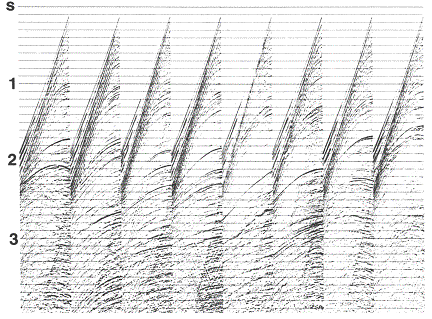
There are two aims to deconvolution. As noted earlier, real sources produce a signals that are not perfect spikes, but ones that has some duration. The first type of deconvolution, spiking deconvolution, attempts to adjust the trace so that it is what would be received if the source signal, or wavelet, were a spike. This is also referred to as wavelet compression. Due to noise and other limitations it is not possible to completely compress the wavelet to a spike, so an approximation is used. The figure below shows the a wavelet, or source signature from an airgun before and after deconvolution and one seismic trace produced by the airgun before and after deconvolution.
The second aim of deconvolution is to remove multiples using predictive deconvolution. Since multiples are the primary signal that has been reflected between two or more surfaces, they have the same shape as the primary signal but are delayed in time. In predictive deconvolution we use a part of the trace as the desired output and try to design a model that will make the trace look like a time-shifted version of itself. Subtracting the model response from the trace removes the multiples. The figure below show the common shot gathers after spiking deconvolution has been applied. Careful comparison to the previous figure will show that the reflections have been compressed and reverberations from the source have been reduced.

Figure 22 CMP gathers after spiking deconvolution.
The second aim of deconvolution is to remove multiples using predictive deconvolution. Since multiples are the primary signal that has been reflected between two or more surfaces, they have the same shape as the primary signal but are delayed in time. In predictive deconvolution we use a part of the trace as the desired output and try to design a model that will make the trace look like a time-shifted version of itself. Subtracting the model response from the trace removes the multiples. The figure above shows the common shot gathers after spiking deconvolution has been applied. Careful comparison to the previous figure will show that the reflections have been compressed and reverberations from the source have been reduced.